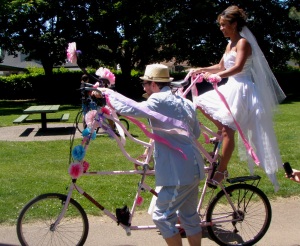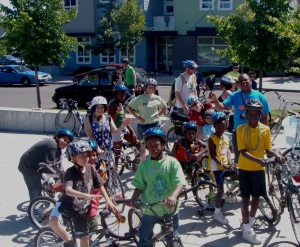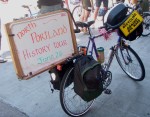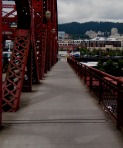I’ve been reading the Portland Bicycle Plan for 2030, which was approved by the city this last February. It is the vision of what Portland will look like in 20 years, and the role of the bicycle in that vision. Portland mayor Sam Adams (below) writes in the forward, “a Portland with the bicycle as a pillar of its transportation is truly a beautiful city.” 
I am struck by two aspects of this statement – first, the concept of biking as a pillar of transportation, which has all kinds of implications, and second, the linking of transportation mode with the beauty of a city. The Plan is very clear: the goal is to make biking a critical component of the city’s transportation system, so that Portland will be cleaner, healthier, attracting tourists and business and keep more money circulating in the local economy.
“Pillar of Transportation”:
To do this, the Plan proposes the city create “conditions that make bicycling more attractive than driving for trips of three miles or less.” More than half of trips in Portland are currently less than 3 miles, a trip that can comfortably be met with a bicycle.
Think of the implications of this bold vision:
- The city will triple the number of miles of bikeways, from the current three hundred to 962 miles; density of bikeways encourages ridership for short trips.
 With the goal of 25% of trips taken by bicycle, there will need to be a strong consideration of road space for these large numbers of riders, including new paths that separate the riders from traffic. Another great phrase in this plan: “safe and comfortable”. Riders need to feel safe and comfortable if a large proportion of residents are going to use their bike. Bikeways need to be designed to provide this sense of saftey and comfort.
With the goal of 25% of trips taken by bicycle, there will need to be a strong consideration of road space for these large numbers of riders, including new paths that separate the riders from traffic. Another great phrase in this plan: “safe and comfortable”. Riders need to feel safe and comfortable if a large proportion of residents are going to use their bike. Bikeways need to be designed to provide this sense of saftey and comfort.- The 20 minute neighborhood: the Portland City Plan promotes mixed use neighborhoods, where residents live within a short walk or bicycle ride to daily destinations. This requires city zoning that allows shops and homes to coexist – a challenge for many neighborhoods.
 Where there are more bikes, there need to be more bike parking. Bike garages, corrals, racks all need to be expanded. I hadn’t given this much thought before, but bikeway development and bike parking development have to go hand in hand. Cities have to use space typically planned for car parking and convert it to bike parking.
Where there are more bikes, there need to be more bike parking. Bike garages, corrals, racks all need to be expanded. I hadn’t given this much thought before, but bikeway development and bike parking development have to go hand in hand. Cities have to use space typically planned for car parking and convert it to bike parking.- The city will need to convert residents who currently are not riding into routine bicyclists. This means increasing ridership among the young, among women, and among seniors. Teaching children bicycle skills at school, and building neighborhoods with safe routes for biking and walking will be important. Many schools today don’t have bike racks nor do they encourage kids to bike. Encouragement of biking will require campaigns, resources and cityscapes that feel safe and comfortable.
So there are all kinds of implications about the work of the city that lie underneath the phrase, “bicycles as a pillar of transportation.” It requires strong political leadership and a commitment to fundamental change to make this happen.
 And it’s all worth it, in order to build a beautiful city! Bikeable streets are often calmer streets, with people on the sidewalks, interesting shops to see, and slower car traffic. Building places that bicyclists and pedestrians want to visit make for a more beautiful city, which is what everyone ultimately wants.
And it’s all worth it, in order to build a beautiful city! Bikeable streets are often calmer streets, with people on the sidewalks, interesting shops to see, and slower car traffic. Building places that bicyclists and pedestrians want to visit make for a more beautiful city, which is what everyone ultimately wants.
Does your city have a bold vision for bike transportation? A simple phrase with profound implications for city building?











